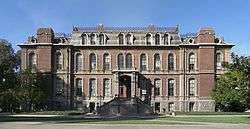South Hall (UC Berkeley)
South Hall is the oldest building on the campus of the University of California, Berkeley, and the only remaining building of the original campus. South Hall was originally the counterpart of North Hall, which no longer exists, but was located where the Bancroft Library currently stands.
South Hall | |
Berkeley Landmark No. 160 | |
 Front of South Hall | |
| Location | Berkeley, California |
|---|---|
| Coordinates | 37°52′16.78″N 122°15′30.59″W |
| Built | 1873 |
| Architect | Farquharson & Kenitzer |
| Architectural style | Second Empire |
| MPS | Berkeley, University of California MRA |
| NRHP reference No. | 82004651 [1] |
| BERKL No. | 160 |
| Significant dates | |
| Added to NRHP | March 25, 1982 |
| Designated BERKL | February 25, 1991[2] |
The first physics laboratory in the United States was hosted in South Hall in 1879. It also has been home to the College of Agriculture, a business school, and a temporary museum for the state geological survey. The University Herbarium was housed in South Hall from 1890 till 1897. It currently houses the UC Berkeley School of Information. When Wheeler Hall was planned, the entrance of South Hall was removed from the west side and added on the east side entrance. The original wooden porch was replaced in 1997 with glass fiber reinforced concrete.
According to legend, the rooftop scene of Mary Poppins was filmed at South Hall, although this has been shown to be false.[3]
Campus tour guides often point out a small stone bear, sculpted by Michael H. Casey,[4] in the architecture of South Hall, on the balcony railing above the entrance, in the third circle from the left, claiming it is the smallest bear statue on campus.
The four-story building is located southwest of Sather Tower.
References
- "National Register Information System". National Register of Historic Places. National Park Service. March 15, 2006.
- "Berkeley Landmarks". Berkeley Architectural Heritage Association. Retrieved 2013-03-04.
- "University of California interactive map". University of California, Berkeley. Retrieved 2007-03-27.
- Helfand, Harvey. University of California, Berkeley. Princeton Architectural Press. p. 43. ISBN 1-56898-293-3.
